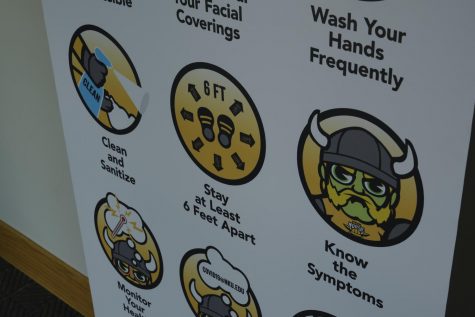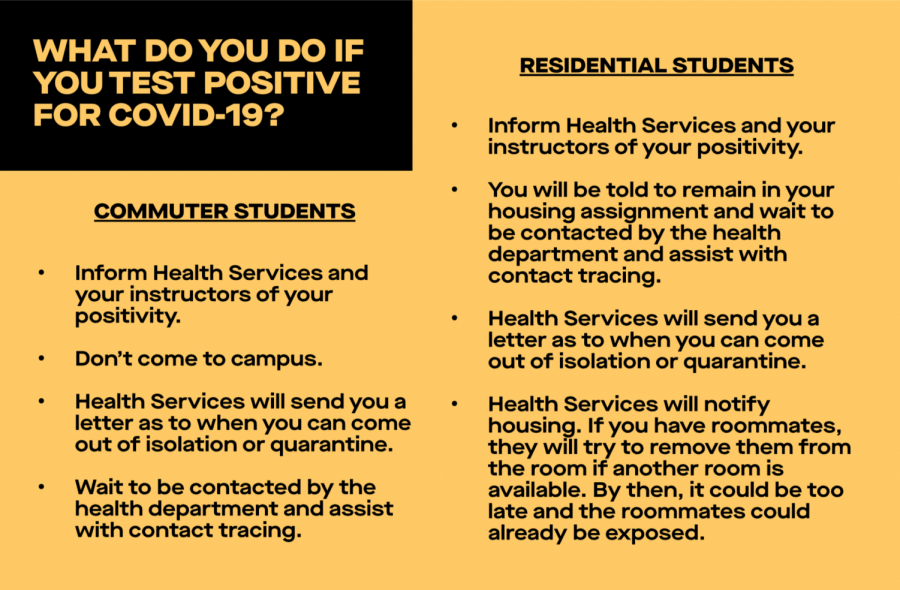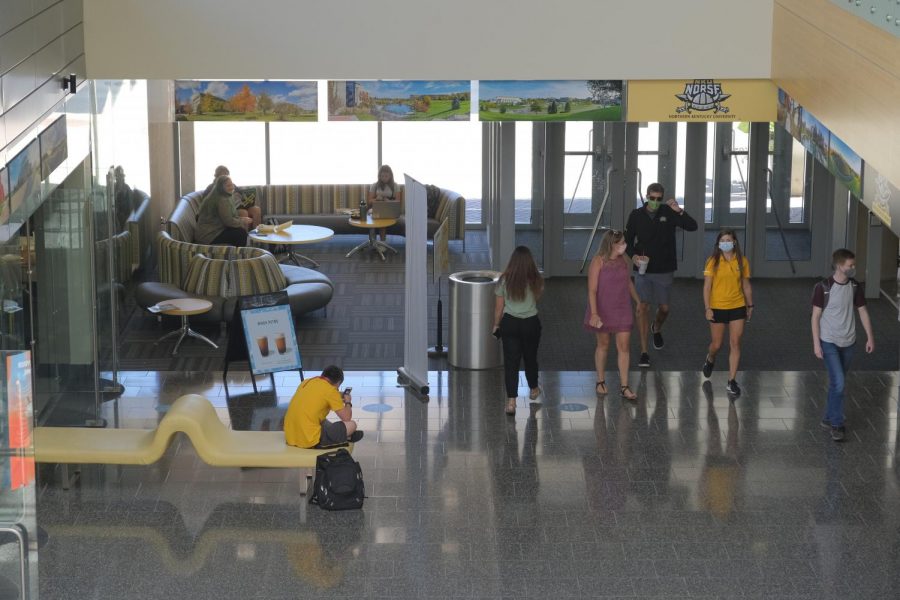Was it safe to return to campus? Faculty and health experts weigh in
September 23, 2020
Several universities have opened for the Fall 2020 semester, leading many to express health concerns related to the ongoing COVID-19 crisis. While even the near future is shadowed in uncertainty, members of Northern Kentucky University attempt to shed light on campus safety during a global pandemic.
Why did we come back to campus?
NKU was able to open campus back up for the Fall 2020 semester due to a regional decline in infection rates, newly implemented guidelines and non-traditional reformatting of courses, according to administrators and health-related data.
“As we planned the best practices for the fall semester, the campus community’s safety and well-being remained our top priority at NKU. The challenge was predicting what the pandemic would look like months in advance,” Dr. Valerie Hardcastle, IHI executive director and vice president for Health Innovation, said in a media statement.
Last semester, NKU organized a COVID-19 Preparedness Team to monitor regional data and draft recommendations for the university. The team includes campus members from several departments, such as Provost Sue Ott Rowlands, Health Services Director Rose Tempel, SGA President Lauren Goodwin and Hardcastle.
According to Hardcastle, the team has monitored regional data throughout the summer to ensure there was not any unexpected outbreak, particularly among the student demographic. The team continues to analyze COVID-19 statistics related to people in between the ages of 20 to 29.
“This age demographic constitutes the majority of our student population, and we are continuing to see a trend toward declining rates of infection there,” Hardcastle said.
According to the Northern Kentucky Health Department’s daily data dashboard, the 20 to 29 age demographic has the most total and active cases amongst all other age groups in the area.
But this trend is not limited to the Northern Kentucky region, Hardcastle said.
According to a recent news briefing by the World Health Organization, there has been a surge of new cases in many Asian countries, and the outbreaks have since been tied to young adults. The New York Times has also reported more than 17,000 cases in total have been linked to American colleges and universities.
“If you’ve been watching the data, the percentage of cases in that demographic has declined since we’ve come back to campus,” Hardcastle said.
NKU has also published a dashboard, which measures both regional and campus-specific data related to COVID-19. According to a chart within that dashboard, there is a noticeable decline in active cases within the 20 to 29 age demographic of the Northern Kentucky area, though the case count continues to fluctuate. On Aug. 18, there were 206 active cases. At the time of reporting, there are 156 cases.
“Our rate of infection [in Kenton, Campbell and Boone counties] is about half of what it is when you look across the state as a whole, so we’re actually doing quite well in comparison to other regions in the state,” Hardcastle said.
NKU also ranks on the lower side of campus-originated cases among other state colleges. According to data released by the Kentucky Department of Public Health, NKU has three active and total cases at the time of reporting. In comparison, Eastern Kentucky University, which has a similar student population, currently has eight active cases and 15 cases have been reported in total.
Administrators have also implemented campus-specific protocols to slow the spread of COVID-19.
Signage is posted throughout campus to encourage students to remain socially-distanced, such as walking on the right side of the sidewalk and hallways and taking the stairs rather than the elevator. Facial coverings are required to be worn at all times, and students must answer symptom-related questions via the Healthy@NKU app before arriving on campus.

Classes have also changed as a result of the pandemic. According to Hardcastle, less than a third of classes have any face-to-face component and 18% of those courses are entirely in-person. This is part of the administration’s plan to “de-densify” the campus so that only faculty and students with essential business are there at any given time.
According to administrators, these guidelines and protocols were designed in order to create a safe environment for students to return to campus.
Why can we stay on campus?
NKU provides a variety of health resources and safety guidelines on campus, but community participation and regional trends will determine how long campus will remain in operation, health officials said.
“Research has shown the masks or the facial coverings, social distancing, cleaning hard surfaces and de-densifying the campus are the best ways to slow a spread,” Rose Tempel, the director of Health Services, said. “If you don’t have as many people on campus, you can allow for better social distancing [and] you have less contact with people who could be positive.”
Health Services has remained open throughout the year, even when campus closed early in March. According to Tempel, Health Services is a main healthcare provider for many students, and they had enough proper PPE to remain secure during the pandemic.
Health Services now works with Gravity Diagnostics, a Covington-based laboratory, to deliver COVID-19 testing to members on campus. If an individual is experiencing symptoms, most insurances will cover the cost of a test.
Without insurance coverage, the price is $59 per test, but NKU has set aside funding for those who do not have the financial ability, according to Hardcastle and Tempel. Those students will have to inform Tempel of their request for university help in coverage of the cost.
Individuals must make an appointment with Health Services for a test, and they will receive the results in approximately 24 to 36 hours.
If a person tests positive on campus, Tempel is required to report the information to the appropriate health department. Protocols following a positive diagnosis is determined based on that person’s specific circumstances.

Positive-testing individuals are also highly encouraged to fill out an online form for NKU’s record keeping. Statistics pertaining to positive-tested campus community members will be reported and disclosed in NKU’s dashboard and the KDPH public records.
If the number of new cases on campus are lower than five, the statistic will show up as “between one to five cases” on NKU’s dashboard. If the number is more than five, the statistic will be published as a specific number. According to Hardcastle, this is to ensure the maximum amount of privacy for individuals so that they could not be singled out on campus.
No publicly identifying information of those tested positive will ever be disclosed to the campus community or the public at large, Hardcastle said.
Members of the community have the most significant impact on whether the pandemic will cause NKU to close early this semester, according to health administrators and faculty.
“Each person has that personal responsibility to follow the rules of campus,” Tempel said.
Students and faculty should also keep each other in check on campus, according to Tempel. If someone is not properly socially distanced or wearing a mask, you should feel comfortable talking with that individual and asking them to respect the guidelines.
“It’s just really changing the culture and saying, ‘This is what we expect of each other,’” Tempel said.
According to Tempel, she has noticed trends amongst other universities that NKU students should be aware of. Attending large gatherings and non-essential travel can quicken the spread of coronavirus, Tempel said.
“The more people gather and socialize, the more likely we are to have an outbreak on campus,” Tempel said. “Student and staff behaviors will determine how healthy our campus will be.”
Randel Plowman is a lecturer in NKU’s visual arts department, and he said student adherence to the health guidelines has increased as the semester continues.
During one of the first few days of classes, he witnessed seven students all enter in a singular elevator. Since then, Plowman said he has not seen any other problem with enforcement.
While enforcement has been generally maintained on campus, Plowman said he hopes students will continue to be cautious and follow safety measures.
“When I was young, I didn’t take a lot of things seriously. It’s easy in your youth to think you’re invincible,” Plowman said.
If a student does not comply with mandatory guidelines, such as social distancing and wearing facial covering, they are in violation of the Code of Student Rights and Responsibilities and could be held accountable by Student Affairs, Hardcastle said.
“But we are trying not to be punitive,” Hardcastle said. “We’re working on it from the positive side. You’ll see people walking around with disposable masks, giving them to students if they see a student who forgot a mask.”
The current plan for the semester is to maintain on-campus services until exam week, which will be delivered through remote learning.
Why will we leave campus?
After Thanksgiving break, finals week will be administered online for all classes at NKU.
“Thanksgiving break is a big travel time for a lot of people. That’s when a lot of extended families get together,” Hardcastle said. “We think it is reasonable to believe that at least some of our students, faculty and staff are going to be going to these gatherings. As a result, the chances are greater—not 100%, but greater—that they might get infected with COVID-19.”
But campus closure also has the possibility of coming sooner than planned.
The COVID-19 Preparedness Team meets on a weekly basis to ensure the community is considered healthy enough to maintain in-person services and courses.
“Primarily what we pay attention to is the number of new cases, the number of active cases, the number of our people who are either isolated or in quarantine,” Hardcastle, who is a member of the team, said. “Also, we look at the rates of infection, so how fast is it spreading?”
There is not a specific point in regional cases that must be reached for a complete or partial closure of campus, but the administration has recently released a document that outlines possible “triggers” for such action.
Some possible triggers that would warrant a complete or partial closure of campus include increasing cases of transmission in the student population, an inability to quarantine or isolate residential students, sustained increase in hospitalizations and government action.
The guideline also outlines possible responses to these issues. Minor actions include increased enforcement of behavioral measures, temporary building closures or a brief suspension of in-person class. More serious responses are the closure of one or more residential halls or campus closure.
“I think the faculty and the departments have been doing a great job with putting out safety measures,” Plowman said. “If everyone just uses caution and takes those measures, I don’t think there’s much to worry about.”

